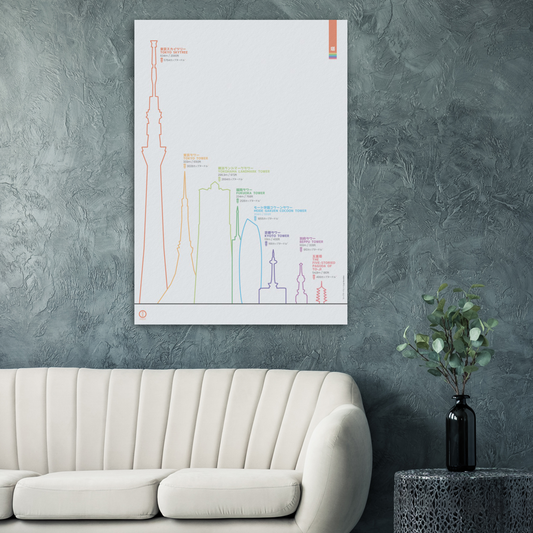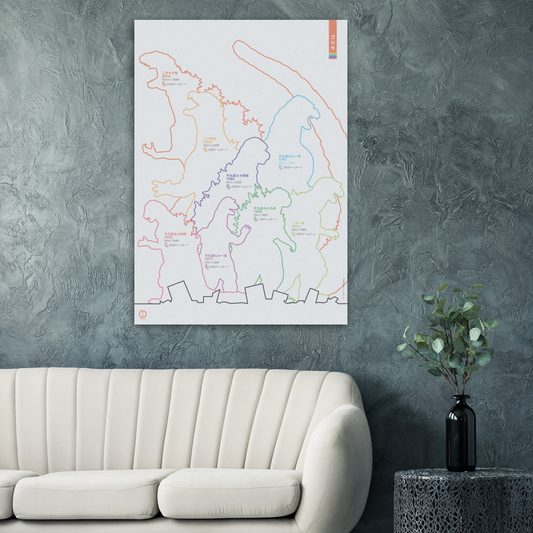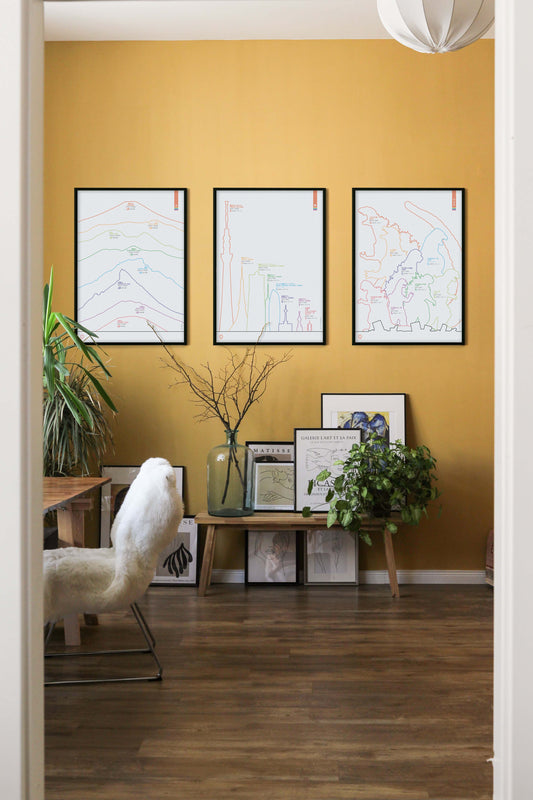
Nature, Urbanization and Kaiju – Exploring Japan through the Scale-It Series
What if you could grasp the scale of Japan through just three posters? The Scale-It Series invites you to explore the country’s contrasts — from sacred peaks to futuristic towers, and the chaotic charm of pop culture icons — all carefully compared by height, in a clean and elegant visual format. Let's dive into the three posters of the series: Mountains of Japan, Towers of Japan, and Gojira Era.
Mountains of Japan – Natural Giants
🏔 Mount Fuji (富士山) – 3,776 m
The highest mountain in Japan and its most iconic. Located between Yamanashi and Shizuoka prefectures, Mount Fuji is a near-perfect volcanic cone that has inspired art, poetry, and pilgrimages for centuries. It's one of Japan’s “Three Holy Mountains” and a UNESCO World Heritage Site. Despite being an active volcano (last eruption in 1707), it attracts hundreds of thousands of climbers each summer for its spiritual symbolism and panoramic summit views.
🏔 Mount Tateyama (立山) – 3,015 m
A sacred peak in the Northern Alps (Toyama Prefecture), Tateyama is linked to the spiritual world and death in traditional mountain worship. It is also a “Holy Mountains” alongside Fuji and Hakusan. The mountain features the famous Tateyama Kurobe Alpine Route and massive snow walls in spring. Its summit, Oyama, is home to a Shintō shrine visited by pilgrims for over a millennium.
🏔 Mount Hakusan (白山) – 2,702 m
Meaning “White Mountain,” Hakusan sits between Ishikawa, Gifu, and Fukui. It’s a dormant stratovolcano known for heavy snowfall and pure water sources. Worshipped since the 8th century, it was first climbed by the monk Taichō. Today, it’s part of a national park and UNESCO Biosphere Reserve, famous for untouched forests and mountain hot springs.
🏔 Mount Kurohime (黒姫山) – 2,053 m
Located in Nagano Prefecture, Kurohime — “Black Princess Mountain” — is a dormant forested volcano rich in local legends. It’s one of the Five Peaks of Northern Shinano and known for its floral displays at the base, especially lilies and cosmos. Accessible by trail, it offers wide views of the Northern Alps and even Mount Fuji on clear days.
🏔 Mount Kurodake (黒岳) – 1,984 m
Situated in Hokkaidō’s Daisetsuzan National Park, Kurodake is a key part of the island’s “Roof of Hokkaidō.” A ropeway and lift bring hikers to 1,500 m, with a trail to the summit. It’s one of the earliest places in Japan to see autumn colors, starting in late August. Its modest elevation belies its dramatic views and alpine landscape.
🏔 Mount Ishizuchi (石鎚山) – 1,982 m
The tallest peak on Shikoku and a center of mountain asceticism (shugendō). Located in Ehime Prefecture, its name means “Stone Mallet Mountain.” Ishizuchi is one of the Seven Sacred Peaks of Japan and features a steep, ritual chain climb to the summit. The spiritual season begins every July 1 with pilgrims in white robes climbing to the shrine at the top.
🏔 Mount Yōtei (羊蹄山) – 1,898 m
Often called “Ezo Fuji” for its symmetry, Yōtei is a stratovolcano near Niseko in Hokkaidō. Though inactive for thousands of years, it dominates the surrounding landscape. It’s part of the Shikotsu-Tōya National Park and included in Japan’s 100 Famous Mountains. In summer, it attracts hikers; in winter, its silhouette towers over Niseko’s ski slopes.
🏔 Mount Ōmuro (大室山) – 580 m
A small but striking grassy volcano in the Izu Peninsula, Shizuoka. Its circular crater is walkable and contains a traditional archery range. Easily reached by chairlift, Mount Ōmuro offers panoramic views of the Pacific and, on clear days, Mount Fuji. Every spring, the entire mountain is burned during the dramatic Yamayaki event to renew the grass cover.
Towers of Japan – Urban Skylines
🗼 Tokyo Skytree (東京スカイツリー) – 634 m
The tallest structure in Japan and the tallest tower in the world, Tokyo Skytree was completed in 2012 in Sumida, Tokyo. It functions as a digital broadcasting tower and offers two observation decks at 350 m and 450 m. Its design blends tradition and innovation, with a tripod base and cylindrical upper shaft. The number 634 is a nod to “Musashi,” an old name for the region covering Tokyo, parts of Saitama and Kanagawa.
🗼 Tokyo Tower (東京タワー) – 333 m
Completed in 1958 in Minato, Tokyo, this red-and-white Eiffel-style tower symbolized Japan’s postwar recovery. For decades, it served as the main broadcast tower for the Kanto region. It remains a beloved tourist spot with observation decks at 150 m and 250 m. You could find a One Piece themed park from 2015 to (unfortunately) 2020. Mascots Noppon (twin pink characters) help maintain its nostalgic charm, making it an enduring icon of Tokyo’s skyline.
🏙 Yokohama Landmark Tower (横浜ランドマークタワー) – 296 m
Located in Minato Mirai 21, this 70-story skyscraper was Japan’s tallest building for 21 years after opening in 1993. It includes offices, shops, and the Royal Park Hotel. The Sky Garden observatory at 273 m offers sweeping views of Yokohama Bay and Mount Fuji. Designed with seismic dampers at the top, it represents Yokohama’s modern ambition and engineering prowess.
🗼 Fukuoka Tower (福岡タワー) – 234 m
Japan’s tallest seaside tower, completed in 1989 for Fukuoka’s centennial. Its triangular shape is clad with 8,000 mirrored panels, earning it the nickname “Mirror Sail.” Located on the coast in Sawara Ward, it offers 360° views from its 3-tiered observatories between 116 m and 123 m. At night, it's illuminated with themed light displays across the seasons. The tower also appears in Gozilla vs. SpaceGodzilla in 1994.
🌀 Mode Gakuen Cocoon Tower (モード学園コクーンタワー) – 204 m
A futuristic skyscraper in Shinjuku, Tokyo, opened in 2008. It houses three vocational schools: fashion, IT, and medicine. Designed like a cocoon to represent nurturing students, the white-diagonal mesh facade and curving silhouette earned it the Emporis Skyscraper Award. It’s one of the world’s tallest educational buildings and a symbol of Tokyo’s architectural boldness.
🗼 Kyoto Tower (京都タワー) – 131 m
Standing directly across Kyoto Station since 1964, Kyoto Tower was built to symbolize the city’s modernization ahead of the Tokyo Olympics. Its sleek, white design resembles a Japanese candle. Observation decks at 100 m offer views over Kyoto’s traditional skyline and surrounding hills. Despite early criticism, it has become a quirky, beloved landmark of the ancient capital.
🗼 Beppu Tower (別府タワー) – 100 m
Built in 1957 in the hot spring city of Beppu (Ōita Prefecture), it was one of the earliest towers in Japan. Designed by Tachu Naitō (who also created Tokyo Tower), it features a Showa-era steel lattice structure. Once used for local TV broadcasts, its observatory at 55 m overlooks steam-filled streets and the bay. Neon signs and retro styling give it a nostalgic charm.
🛕 Tō-ji Pagoda (東寺五重塔) – 54.8 m
Another kind of tower here, we wanted to include one from the past to give a slightly different (time) perspective. The tallest wooden pagoda in Japan, located at Tō-ji Temple in Kyoto. Originally built in the 9th century and rebuilt in 1644, it is a designated National Treasure. The five-tiered structure symbolizes the five Buddhist elements. Though rarely open to the public, the base houses esoteric Buddhist statues. Its silhouette rising above Kyoto’s temples and cherry blossoms is one of the city’s most iconic images.
Gojira Era – Fictional Scale, Real Impact
🦖 Godzilla (1954 – ゴジラ)
The original Godzilla, introduced in the 1954 film Gojira, stood at 50 m and emerged as a terrifying metaphor for nuclear devastation. Its design (Shodai-Goji) featured rough, keloid-like skin, maple-leaf dorsal plates, and a pale atomic breath — all evoking radiation scars and post-war trauma. With no heroic intent, this creature was a destructive force awakened by nuclear tests. Brought to life by actor Haruo Nakajima in a heavy rubber suit, it marked the birth of the kaijū eiga genre and became a global icon of cinematic horror and anti-nuclear commentary.
🦖 Godzilla (1971 – ゴジラ対ヘドラ)
In Godzilla vs. Hedorah, this Showa-era Godzilla had transformed from a threat into a protector of Earth. Standing again at 50 m, this version battled Hedorah, a pollution-born monster, in a surreal, eco-conscious film. The design (based on Soshingeki-Goji) was more anthropomorphic — wider head, large expressive eyes, and a gentler demeanor. This Godzilla could fly using its atomic breath in one of the most bizarre scenes in the franchise. It reflected the early '70s shift toward children-oriented storytelling and environmental messaging.
🦖 Godzilla (1984 – ゴジラ)
The Return of Godzilla brought back Godzilla as a dark, serious threat, discarding the campy tone of the '70s. Now 80 m tall to match Tokyo’s modern skyline, this version (84-Goji) had coal-gray skin, a longer snout, larger claws, and fierce, pupil-less eyes. The film re-established Godzilla as a destructive and unknowable force, a Cold War-era allegory that raised global tensions in the plot between the USSR and the USA. It marked the beginning of the Heisei era with a grim, politically charged reboot.
🦖 Godzilla (1991 – ゴジラVSキングギドラ)
This Heisei-era version appeared in Godzilla vs. King Ghidorah, where time travel altered its origin and increased its size to 100 m. The design (Ghido-Goji) was powerful — broad chest, muscular frame, large dorsal fins, sharp orange eyes, and subtle ear shapes. It fought and defeated King Ghidorah with overwhelming strength. The backstory reimagined Godzilla as a dinosaur mutated by nuclear radiation (Godzillasaurus), adding emotional weight. This version represented peak Godzilla as an unstoppable anti-hero.
🦖 Godzilla (1999 – ゴジラ2000 ミレニアム)
In Godzilla 2000: Millennium, Toho rebooted the franchise post-Hollywood 1998. This Godzilla (Mire-Goji) was around 55–60 m tall, with dark green skin, jagged purple dorsal fins, and a wilder, reptilian look. With visible fangs and golden eyes, it fought the alien monster Orga and showcased rapid regeneration. This version symbolized a “re-Japanized” Godzilla — back to aggressive, unpredictable form, yet not entirely malicious. It set the tone for the Millennium era with a fresh visual identity and sci-fi flair.
🦖 Godzilla (2001 – GMK)
In Godzilla, Mothra and King Ghidorah: Giant Monsters All-Out Attack (GMK), Godzilla was reimagined as a supernatural entity possessed by the restless souls of war victims. Standing at ~60 m, its design (GMK-Goji) was ghostly — pure white eyes, rugged scars, and asymmetrical, bone-colored dorsal fins. This Godzilla acted with cruelty and no rational motive, becoming the embodiment of karmic vengeance. It reversed roles by casting King Ghidorah as a guardian. GMK’s Godzilla was one of the darkest and most visually haunting incarnations ever seen.
🦖 Godzilla (2004 – ゴジラファイナルウォーズ)
Created for the franchise’s 50th anniversary, Godzilla Final Wars presented a leaner, more athletic Godzilla (Final-Goji) at 100 m tall. With sharp red eyes, silver dorsal fins, and a flexible build, this version showcased martial prowess in fast-paced battles against multiple monsters. Designed for agility and action, it sprinted, leapt, and struck with precision — a stark contrast to earlier lumbering versions. Final-Goji was a celebratory “superhero” Godzilla, embracing spectacle and nostalgia with a heroic edge.
🦖 Godzilla (2016 – シン・ゴジラ)
Shin Godzilla, directed by Hideaki Anno, radically reinvented the monster as an evolving biological disaster. At a record 118.5 m, it started as an aquatic creature before mutating into a towering horror. With burnt-black skin streaked with glowing red fissures, fixed eyes, and a split jaw, this Godzilla used devastating purple atomic beams — from its mouth, dorsal fins, and even tail. Symbolizing bureaucratic paralysis and post-Fukushima fears, Shin Godzilla became a chilling metaphor for modern crisis mismanagement and earned widespread acclaim in Japan.
Three Posters, One Concept
Through Scale-It series, we have explored Japan’s geography, cities, and imagination, side by side, to scale. Whether it’s sacred peaks, steel towers, or cinematic giants, each poster invites you to see Japan from a new perspective.
Explore the full Scale-It Series now — available individually or as a full set.



